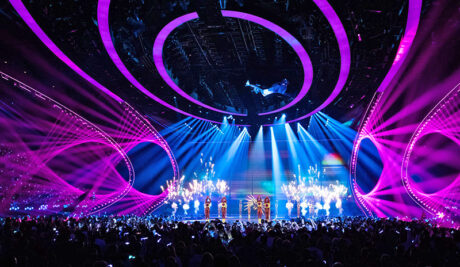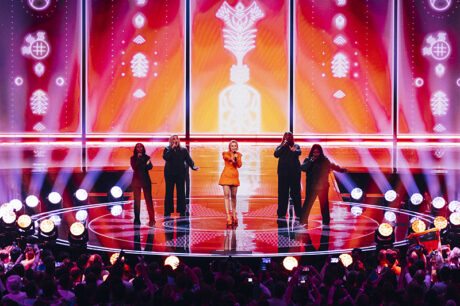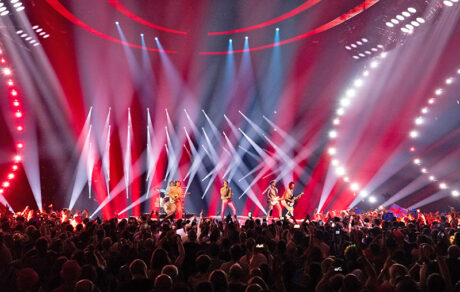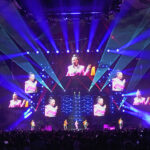
In a unique collaboration, the 67th Eurovision Song Contest, that annual extravaganza of music and lighting, was hosted in Liverpool by the UK, on behalf of last year’s winners, Ukraine—marking the first time two countries have co-hosted the event. Two semi-finals on May 8 and 11 saw 37 acts whittled down to 26 finalists for the spectacular Grand Final on May 13 at the Liverpool M&S Bank Arena. The show was broadcast globally to more than 160 million viewers, who saw Sweden’s Loreen win.

Eurovision Beams
In what he calls “a dream-come-true project,” multi award-winning lighting designer, Tim Routledge and his team were responsible for every aspect of the lighting including all 37 performances, presentation states, commentator boxes, voting sequences, and the half-time and opening shows for the two semi-finals and Grand Final. This massive undertaking was based on briefings, renders and notes—mostly delivered remotely—and a 20-minute meeting with each of the countries’ delegations in March. “We had to focus on the key points from each to realize their design wishes, and work fast to deliver everything within the time frame,” says Routledge.
With such tight time schedules and high-profile exposure, Routledge needed equipment that was fast, accurate, versatile and reliable. He chose Ayrton’s new Zonda 9 FX, Karif LT, MagicBlade R and the laser-sourced Cobra as key components of his lighting inventory. Ninety Zonda 9 FX were used to create 10 ‘Svoboda 3000’ pods, Routledge’s modernized recreation of the classic Svoboda batten, which he says were a ‘massively important feature’ in the show. The pods were mounted on independent automated hoists, and tessellated within the three concentric rings of oval lightboxes above the center stage to form one big curve, and could each be lowered and raised at will. “I’ve always loved those Svoboda lights, plus it was a kind of nod to my late father who first gave me a book on Josef Svoboda when I was young,” says Routledge. “We wanted to create a Svoboda pod that was epic and could fly in and out individually.”
Zonda 9 FX’s large face was ideal for providing the eye candy and dressing looks that Routledge was after, as well as performing as a punchy wash light. “Zonda 9 FX has great power, but we chose it mainly for the clever matrix effect (LiquidEffects™) on the front,” he says. “These gave really cool looks to fill the shots when they were dropped in low, and also had the ability to create something pretty without having to blow the shot with loads of powerful light – they looked great without even having to use their punch. They proved very popular with the delegations and fulfilled the brief of what I was trying to do with the pods perfectly.”

Ninety-six MagicBlade R were rigged in the central chandelier feature that filled the space between the oval light boxes in the center of the arena. These were used for “fun stuff and sky eye candy filling the center spot above the oval stage.” Fifty laser-sourced Cobras, which can narrow down to the tightest of beams at 0.6°, were rigged down the sides of the arena to provide big beam looks for all the audience ‘down-the-room’ shots and dressing shots for camera reverses. “The Cobras were used really well on several numbers, especially France’s prop which was edged in a mirror ball fascia, and during the Semi-Final 1 half-time show when the performers opened up their costumes to reveal a mirrorball textured heart jacket,” says Routledge. “We pointed the Cobras at those with phenomenal effect. At another point, Spain wanted their artist to scoop up a beam of light in her hand—one Cobra was aimed at a specific spot for a closeup on her hand bathed in high intensity light that looked she was literally holding light. The punch and the tight beams the Cobras gave us shooting from 80m—well they were brilliant in every sense of the word!”
Thirty Karif LTs were rigged around the arena on goal posts to provide back beams for the audience shots and add background texture to the oval stage’s left and right wings. “To avoid compromising audience sightlines,” explains Routledge, “we were quite restricted for space and height, so I needed a compact beam light that would work well in those tight spaces. Finding the right LED fixture that was small and fast was the challenge, and Karif LT fitted the bill really well.”
He concludes noting, “I want to heap praise on my programmers Tom Young, Alex Mildenhall and Mark Nicholson who programmed over 79,000 beat-perfect precise lighting cues, and my associate LD, James Scott, for helping this dream come to fruition.” Neg Earth Lights was the official lighting supplier for Eurovision Song Contest 2023, with great technical support by Ambersphere.

Eurovision’s 40 Million Pixels
Creative Technology were commissioned by Luke Mills and Gary Beestone of GBA on behalf of BBC Studios to provide a variety of LED solutions that brought together the impressive stage design by Julio Himede, realized by technical team headed up by Matthias Kublik alongside lighting designer, Tim Routledge. Recognizing that the world’s biggest singing contest had made its way to the UK to be hosted in Liverpool on behalf of the 2022 winner Ukraine due to the ongoing war, the event’s theme was ‘United by Music’. A theme the stage design concept was created to reflect—resembling a wide hug, the entire architecture of the set symbolizes welcoming the people of Ukraine and Europe with open arms.
Taking center stage were seven ROE Black Quartz LED towers, two larger outer towers measuring 4×10 m and five slightly smaller inner towers measuring 3×10 m. The towers were attached to an automation system supplied by Belgium based company WICREATIONS. These systems not only allowed for upstage and downstage tracking of all 7 towers but also rotation up to 720-degrees of the inner towers, enabling some incredibly dynamic and versatile stage sets for each of the 31 acts representing their countries throughout the two televised semi-finals and grand final show. The two curved LED side walls enveloped the stage with custom fabricated metalwork created by Stage One, this gave the stage a visually interesting shape for all members of the 11,000 strong audience within the M&S Bank Arena as well as the 161 million people watching across the 3 live shows from home. Graham Miller, Head of Music/Entertainment at Creative Technology UK explains, “Black Quartz was chosen as it is such an impeccable looking screen and with 10-bit processing, we knew this would work well for live broadcast. Utilizing 4mm products for the majority of the surfaces within the arena made for a sharp and vibrant display that could be appreciated both within the venue and watching on TV.
Working closely with sister company Faber, with assistance from Project Manager, Steve Ackein, a two-part LED floor made up of over 700 panels of ROE Black Marble covered the large oval, catwalk, and upstage sections of the stage. This provided a high-resolution canvas for each of the artist’s unique performances as well as intricately working as a map to assist with the rapid set changes between each act. A ‘digital spike system’ was deployed to display plans for the show crew for prop positioning and LED extras to ensure perfect placement ready for the next live act to begin. This spike system and all content playback was managed by Chris Saunders from Ogle Hog running on disguise servers. To bring everything together, 41 sqm of LED panels of ROE Vanish 8mm were supplied to create a ceiling with 6 flown elements—for the desired curved effect, facia masking was provided by Stage One.
On top of the static LED elements, Creative Technology also provided multiple extras for many of the acts including UK star, Mae Muller, who began her performance upon an 8x2m LED riser on custom dollies. The hardworking LED technical team and stage crew had the challenge of bringing the additional screens onto stage, joining them together and ensuring everything was working ahead of the live performances—all in less than 90 seconds. For Sweden’s winning performance a 2.5×2.5m flown LED screen was built into a custom frame with automation by Unusual Rigging to create a moving ceiling. With another quick change over this was rolled onto stage and fully active within just 30 seconds. Other additional LED elements for two interval acts included 5 custom LED risers of assorted sizes for the Welcome to Our House, performed by Ukrainian singer Alyosha—produced by Freckled Sky and 3 sections tracked LED for the Be Who You Wanna Be performance.
For signal distribution a bespoke fiber hub was positioned on stage right, linked to 24 processors with over 2km of fiber providing full redundancy at every point. An in-house developed LED processing feedback system was used to efficiently monitor faults and system warnings which helped support the team with identifying and fixing issues simply and quickly. Arkadiusz Wegrzyn Project Manager at Creative Technology UK concludes, “The team onsite throughout the build, rehearsals, live shows, and de-rig were incredible. The hard work and attention to detail from every single person made this show a pleasure to project manage and I am so proud of what was achieved!”


